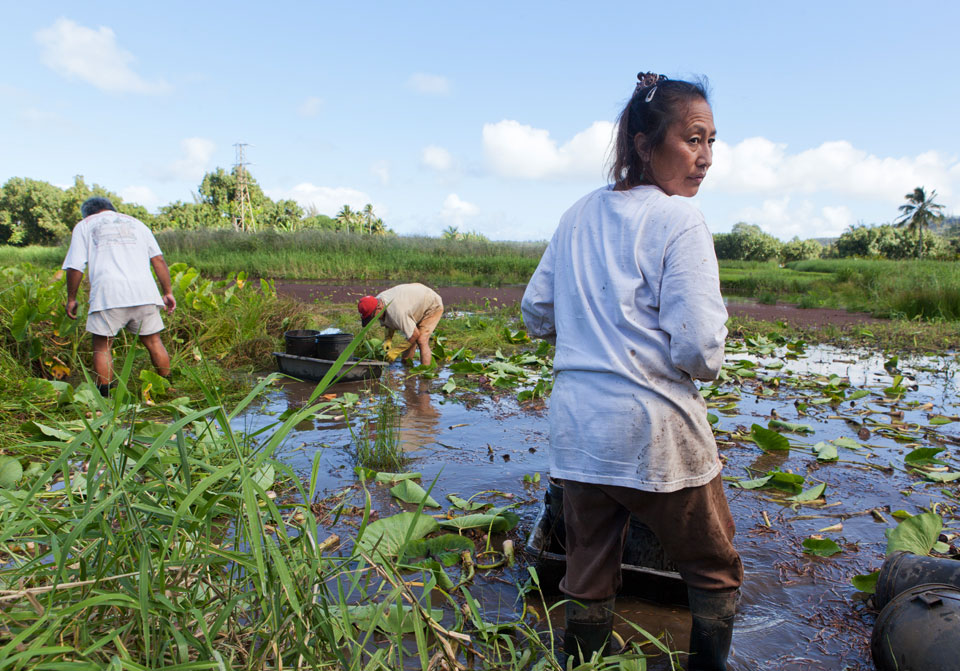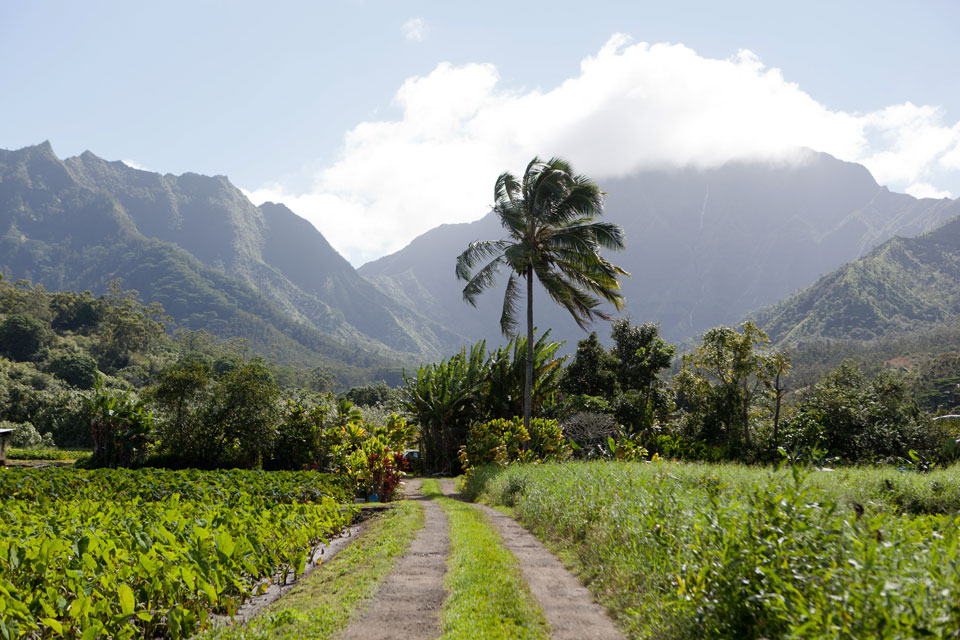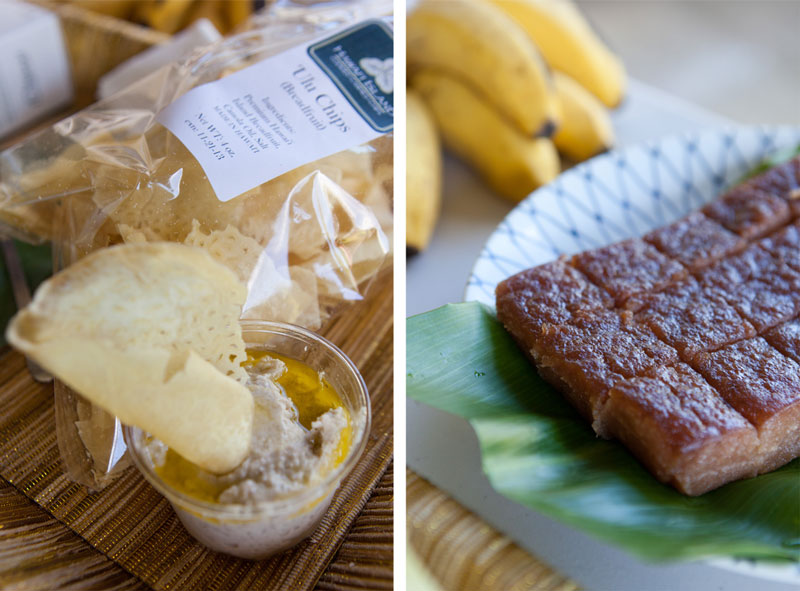Can the Aloha State transition to growing enough food to sustain its population using small-scale, agroecology practices?

Chris Kobayashi & Dimi Rivera. Photo by Ian Umeda
The couple knew that it would be a tough vegetable to grow. Cucumbers (and melons) are prone to extensive damage from fruit flies in Hawai'i. So they covered every single cucumber that came up with plastic bags. "We'd charge a dollar for each at the farmers' market," says Kobayshi. "We set up a sign on that said 'Japanese Cucumbers, $1.' We offered samples and people got hooked because it's so crunchy. Then they started asking, do you have any kale? I was like, 'Kale? What is that?' So that's how we started growing other kinds of veggies. It was just all an organic thing that happened. None of this was planned." Today, Kobayashi's family's 10-acre Waioli Farm, named after the stream that runs beside it, grows produce using organic practices – mainly taro, which they supply to families and traditional poi (taro paste) makers on Oahu and the Big Island, but also some fruits and vegetables for their local farmers' market stand.
Kobayashi, whose family has been growing taro commercially for generations, is a member of Hawai'i SEED, a coalition of grassroots citizen groups and food activists that is working to promote ecological food and farming in Hawai'i. Earth Island Journal (EIJ) met with her when reporting on the growing Hawai'i citizens' movement against the genetically modified seed industry in the islands. (Read the in-depth story on the issue here.) To be more specific, EIJ met with her, and several other small scale farmers on Kaua'i and O'ahu, in an effort to understand whether there were indeed any viable alternatives to industrial-style farming in Hawai'i. Could this remote island chain, which currently imports nearly 90 percent of its food, transition to growing enough food to feed itself though small-scale, agroecological farming?
Kobayashi certainly thinks so. "Have you seen this?" she asks, sweeping an arm to indicate the lush fields and emerald mountains around us. "Over here we have year-round warm weather, we have land, we have water... We just need more farms that produce food." Of course, the transition would have to be more intentional than how she started out, and it would require setting up complementary cottage industries that could employ more people, she adds. "It will be a lot of hard work, but it can be done... I can see a vibrant economy take shape."
The thriving local food economy on Kaua'i's North Shore – with its diverse community of homesteaders, small-scale farmers like Kobayashi and Rivera, and upscale homeowners and tourists who often buy out the farmers' markets in a matter of hours – offers a window into what's possible in Hawai'i.
A widespread switch in farming systems, however, would first require a larger shift in perception of what most Hawaiian residents (and in fact, most Americans) consider the kind of farming that feeds and employs the multitudes. In Hawai'i specifically, the problem is that because of the islands' colonial history, its people have been alienated from their traditional livelihoods and sustainable agricultural practices, says Albie Miles, director of the University of Hawai'i - West O'ahu's Sustainable Agriculture program.
Large scale, plantation-style agriculture was a centerpiece of Hawai'i's economy for more than a century, until competition from overseas drove local sugarcane and pineapple plantations out of business in the 1990s, leaving many jobless. The dying plantations were then replaced by large biotech seed farms. For many Hawaiians, who worked or grew up with this kind of agricultural system, it's impossible to even conceive that islanders can sustain themselves without Big Ag. As Kaua'i Mayor Bernard Carvalho told me: "This kind of agriculture really feeds our families."
What Hawaiians forget, Miles says, is that the islands have another, much older agricultural and land-use history – one that is deeply intertwined with the region's environment and indigenous culture, one that had sustained the people of this remote island chain for several centuries before the arrival of the first European explorers.
The early Hawaiian settlers, who arrived in the uninhabited islands around A.D. 300 from Polynesia, developed a unique system of resource management to support their growing population. Recognizing the connection between the mountains and the oceans and the key role of freshwater in linking the two, they divided the islands into self-sustaining units called ahupua'a. The ahupua'a were usually wedge-shaped sections of land that ran from the mountains to the sea (extending into coastal fishing grounds) and contained a freshwater source such as a stream, spring, or river. Each ahupua'a contained within it all the resources needed for a community to sustain itself independently.

Photo by Ian Umeda.
There are few ahupua'a left intact in Hawai'i today (Kobayashi's farm is part of a fractured one), and none of them can support an entire community as in pre-industrial days. But some interesting efforts to restore versions of this ancient land-use system are being undertaken by organizations like the Waipa Foundation and the Limahuli Garden and Preserve, which lies just a little further north of Kobayashi's farm on Kaua'i's North Shore. Hawai'i's grassroots movement against the biotech farms and industrial agriculture finds much strength in this ancient agrarian history.
While it's unlikely that the islands can completely revert back to the ahupua'a system, it does offer a model of self-sufficiency that can be emulated, says environmental lawyer and author Claire Hope Cummings. "Most of the country has this mix of the means needed for local food and fuel production, and a choice of models," Cummings writes in her book Uncertain Peril: Genetic Engineering and the Future of Seeds. "But very few places have the needed leadership and proven ways to go about creating our ideal of diverse and locally controlled economies." Hawai'i, she says, is one of them.
Like Cummings, many farming experts and food activists say Hawai'i has to look beyond its colonial history to find the way forward to a food-secure state. The kind of agricultural model they are looking back to, and would like to see take root in Hawai'i, is gaining increasing international support.
A large body of scientific research – including studies by nonpartisan organizations such as the National Academies of Sciences, the United Nations Committee on Trade and Development, and the lesser-known, but hugely important, International Assessment of Agricultural Knowledge, Science and Technology for Development (IAASTD) – indicates that the best way to ensure food production as the world's population grows (and its climate changes) is by transitioning from the industrial, monocrop model to smaller, biologically diversified, agroecological systems that have proven to be better at addressing the challenges of food sovereignty, preserving biodiversity, and reducing poverty.
In fact, such food systems are already feeding most of the world. According to a 2012 report by the Canadian research and advocacy organization, ETC Group, at least 70 percent of the food the world consumes every year is grown by small-scale rural and urban farmers, while industrial farming, which gets most of the attention, land, and R&D dollars, actually produces only about 30 percent of the world's food. "Our 70 percent estimate is inadvertently corroborated by the fertilizer industry who worry that somewhere between 40 per cent and 60 per cent of the world's food is grown without their synthetic chemicals," notes Pat Mooney, the group's co-founder and executive director.
Unfortunately, research and development related to diversified farming systems receives minimal funding. (In the U.S., it gets less than two percent of public agricultural research funding.) Hawai'i University's Albie Miles argues that this neglect has led to a "knowledge gap" that makes it easy for Big Ag supporters to cite a "yield gap" between agroecologial and industrial food production. "The estimated 10 to 15 percent yield gap has to be understood in the context of historic underfunding of crop development using organic and agroecological farming methods," he says. "Even with a small investment into these alternative methods, we'd be able to close the yield gap." Miles believes that if the U.S. Department of Agriculture shifted its focus toward research and education in agroecology and biologically diversified farming systems, the potential to address global resource challenges would be enormous.
The state of Hawai'i came pretty close to making that shift on its own just two decades ago. When the plantation economy crashed in the nineties, the state agriculture department considered replacing the plantations with a more community-friendly model that included small farms growing diverse crops.

Photo by Ian Umeda.
Most of these companies produce commodity crops, mainly genetically engineered seeds, which get shipped to the U.S. mainland and overseas, leaving the islands heavily dependent on food imports.
"Everyone realizes that Hawai'i is in an incredibly risky situation in terms of food security," Miles says, referring to reports that show that in case of a disruption in shipping the state's inventory of fresh produce would feed Hawaiians for no more than 10 days. But, he says, there's clearly a way out of this precarious position that could also create jobs and sustain the local economy. A recent Hawai'i State University study estimates that replacing just 10 percent of imported food with locally grown food would create about 2,300 jobs (about the same number that the seed industry provides) and keep $313 million circulating within Hawai'i's economy. Miles says the state government needs to make "some serious choices" about its agriculture sector and needs to start removing the "structural obstacles" in the way of small, diversified farms.
The obstacles aren't small, either. For starters, there's the problem of providing potential smallholders access to land. Much of the state's 280,000 acres of arable agricultural land belongs to big trusts set up by erstwhile plantation barons and Hawaiian royal families who prefer the security of leasing out or selling large parcels rather than divvying their land up in five to 10 acre (or smaller) sections. They can't really be blamed for that either, given the massive property tax burden that they have to bear. (Kobayashi says a possible solution could be giving landowners some kind of tax incentive for taking a chance on new farmers.)
Then there's the issue of finding enough people willing to take up farming in the first place – a core problem facing the agricultural sector worldwide. Scott Enright, the chair of the Hawai'i Board of Agriculture, told me there simply weren't enough people in Hawai'i who were interested in taking up farming, or who had the basic knowhow in the first place. "But that said, we are looking to open up land in Kehaka [in Kaua'i] for agriculturalists. We'll see who steps forward," he says.
Farming advocates counter that the onus is on the state to invest time and money in teaching Hawaiians how to farm. "When the plantations closed, about 200 farmers were given two acres of land [each] to cultivate, but they weren't given full support. We didn't show them how to farm. So after a few years they gave up," says Hector Valenzuela, a crop scientist at Hawai'i University. "Even at the [state-run] university, we diverted our attention to GMOs. Crop scientists shut themselves up in labs when they should have been in the fields, showing farmers how to grow food," he says. "The hardest thing to do is to convince somebody to start farming, so when one decides to do so we have to help them succeed."
Back at Waiole Farm, Kobayashi says that it is pretty clear Hawai'i needs to start the transition with some rulemaking. "I don't know how to put it all together, but that's what we want to work on... It's quite a big complex issue, but we've just got to start chipping away."
This article is part of "What The Fork!?! Corporations and Democracy," a collaborative media effort investigating corporate control of our democracy and our dinner plates, and was first published by Earth Island Journal. Articles and radio pieces combine work of Making Contact, The Progressive, the Center for Media and Democracy (publisher of ALECexposed.org), and Food Democracy Now, along with reporting from Earth Island Journal, Grist, and Cascadia Times. Made possible in part by the Voqal Fund. Read stories and take action at wtfcorporations.com, and follow #wtfcorps and #BigAg on Twitter and Facebook.
Maureen Nandini Mitra is Managing Editor of Earth Island Journal. In addition to her work at the Journal, Mitra writes for several other magazines and online publications in the US and India. A journalism graduate from Columbia University, her work has appeared in the San Francisco Public Press, The New Internationalist, Sueddeutsche Zeitung, The Caravan and Down to Earth.
'庫間 > 해외자료' 카테고리의 다른 글
| 중국의 심각한 토양오염 (0) | 2014.07.02 |
|---|---|
| 나무와 함께 짓는 농사 (0) | 2014.07.02 |
| 인도의 급속한 사막화 (0) | 2014.06.27 |
| 염소가 도시농업의 미래가 될 수 있을까 (0) | 2014.06.27 |
| 다음 세대의 유전자변형 작물이 도달했다 (0) | 2014.06.27 |


